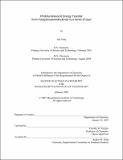| dc.contributor.advisor | Timothy M. Swager. | en_US |
| dc.contributor.author | Song, Inja, S.M. Massachusetts Institute of Technology | en_US |
| dc.contributor.other | Massachusetts Institute of Technology. Dept. of Chemistry. | en_US |
| dc.date.accessioned | 2007-08-29T19:05:50Z | |
| dc.date.available | 2007-08-29T19:05:50Z | |
| dc.date.copyright | 2007 | en_US |
| dc.date.issued | 2007 | en_US |
| dc.identifier.uri | http://hdl.handle.net/1721.1/38522 | |
| dc.description | Thesis (S.M.)--Massachusetts Institute of Technology, Dept. of Chemistry, 2007. | en_US |
| dc.description | This electronic version was submitted by the student author. The certified thesis is available in the Institute Archives and Special Collections. | en_US |
| dc.description | Vita. | en_US |
| dc.description | Includes bibliographical references (p. 45-49). | en_US |
| dc.description.abstract | Photoluminescent energy transfer in conjugated polymer-dye blend films was studied by means of steady-state fluorescence spectroscopy in order to identify efficient energy acceptors with red-shifted emissions relative to donor emission. A dialkoxy substituted poly(phenylene- ethylene) (PPE) and its pentiptycene derivative were used as the energy donor, and xanthene, cyanine, phenoxazine, and squaraine dyes were utilized as energy acceptors. Energy transfer efficiency was investigated by exciting the polymer and monitoring the quenching of polymer emission, along with the enhanced dye emission. Squaraine dyes exhibited up to 110 times greater emission than the intrinsic dye emission, even though they have little spectral overlap with the polymer donor. Moreover, even after normalization for the degree of spectral overlap, the sensitized emission intensity of squaraine was unusually high relative to those of the other dyes. This result suggested that an alternative Dexter mechanism substantially contributes to efficient energy transfer beyond the "through-space" dipolar mechanism of the Forster theory. This process is additionally assisted by the internal free volume within specific polymer hosts that prevent phase separation and self-aggregation of dyes, as well as preserving the dye emissive within the interstitial cavity. | en_US |
| dc.description.abstract | (cont.) Lastly, other factors that influence energy transfer, such as optimum doping concentration and the specific affinity of dyes to polymers, were investigated. The results provide crucial insights into the identification or design of competent energy acceptors and donors. | en_US |
| dc.description.statementofresponsibility | by Inja Song. | en_US |
| dc.format.extent | 50 leaves | en_US |
| dc.language.iso | eng | en_US |
| dc.publisher | Massachusetts Institute of Technology | en_US |
| dc.rights | M.I.T. theses are protected by copyright. They may be viewed from this source for any purpose, but reproduction or distribution in any format is prohibited without written permission. See provided URL for inquiries about permission. | en_US |
| dc.rights.uri | http://dspace.mit.edu/handle/1721.1/7582 | |
| dc.subject | Chemistry. | en_US |
| dc.title | Photoluminescent energy transfer from poly(phenyleneethylene)s to a series of dyes | en_US |
| dc.title.alternative | Photoluminescent energy transfer from PPEs to a series of dyes | en_US |
| dc.type | Thesis | en_US |
| dc.description.degree | S.M. | en_US |
| dc.contributor.department | Massachusetts Institute of Technology. Department of Chemistry | |
| dc.identifier.oclc | 156997596 | en_US |
